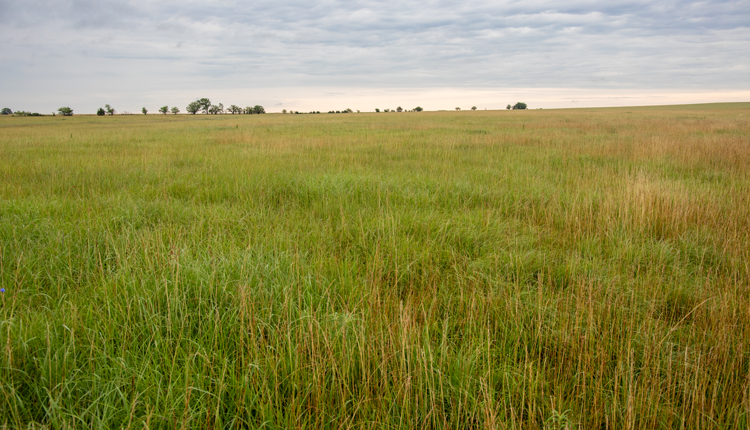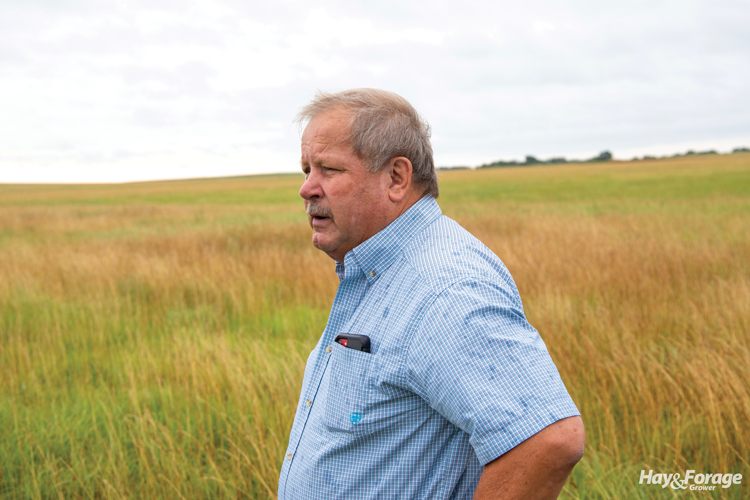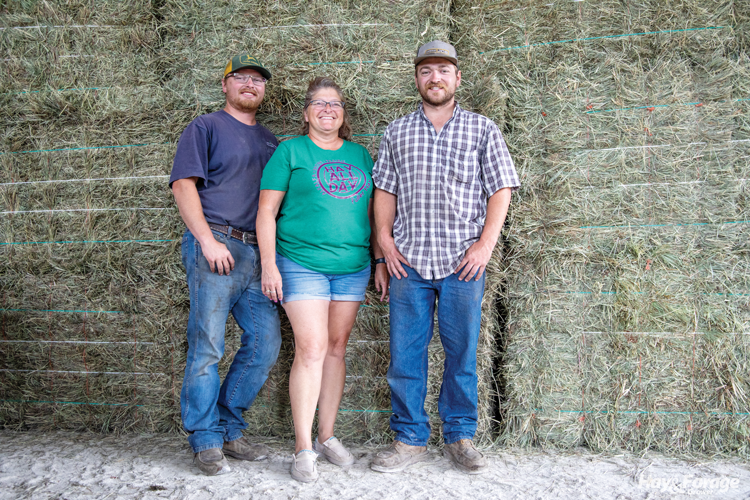
Perennial forage production takes on many different faces across the United States. It may range from endless acres of tall fescue, to green and growing bermudagrass, to field after field of Western irrigated alfalfa.
On the upland prairie of eastern Kansas, near the city of Emporia, it’s native bluestem grasses that provide the bulk of production for many of those who call themselves haymakers. The thousands of acres of big and little bluestem have covered this area for generations, providing either pasture for grazing cattle or the production of what is simply referred to as prairie hay. Make no mistake; it’s big business.
When John Waechter graduated from high school in 1973, he was offered a football scholarship to Emporia State University. He had grown up as one of 10 children on his parent’s farm outside the rural town of Olpe, about 10 miles south of Emporia. Waechter didn’t take the college offer; he was more interested in getting paid 35 cents a bale to move and stack hay out of neighbors’ fields.
A year and a half after high school, Waechter went into the hay business for himself. “I bought some junk equipment and leased 230 acres of prairie grass,” he said of his humble beginnings. “At the time, I was the youngest member to join the National Hay Association. Starting out was a battle at first, but I just kept advertising, adding, and growing.” One might say that’s an understatement, as today Waechter Hay and Grain Farms Inc. consists of over 11,000 acres of owned land and entails three different enterprises: hay, grain, and commercial trucking, and they all work hand-in-hand. The veteran haymaker is most proud of the fact that he’s been debt free for over 10 years.
Hay in high demand
Waechter’s hay operation consists of over 2,300 acres of prairie grass, 2,000 acres of leased prairie grass, 600 acres of smooth bromegrass, and 250 acres of alfalfa, which is seeded during late summer and persists for four to five years. He also bales a couple hundred acres of wheat straw. “We were growing more alfalfa, but the recent high grain prices prompted us to replace some of those acres with wheat and soybeans,” Waechter explained. “We’ll probably get back to more alfalfa in the next couple of years.”

The goal for the prairie grass hay is to harvest 1.5 tons per acre. All of the grass acres are sprayed to control broadleaf weeds each spring using two 120-foot boom sprayers. The prairie grass acres are cut once per year with two New Holland self-propelled 18-foot mowers. “We usually start in early July and just keep mowing until we’re done,” Waechter said.
Both the prairie and bromegrass hay are mowed one day, raked the next with two Vermeer basket rakes, and usually baled on the following day. Waechter harvests his production as 4x4, 3x3, or small square bales, depending on the hay type and final market. He noted that a lot of customers like the 3x3 bales because they can be easily handled with a skid loader. Dairies and feedlots take the 4x4 bales while most of the small square bales go to horse owners and stables. Hay is stored in five hay barns that are scattered around the farm’s acreage.
“The feedlot industry in western Kansas uses a lot of our prairie hay production, but we send it everywhere,” Waechter explained. “The four big feedlots we deal with each take about 150 semitrailer loads per year. In fact, we have to buy some hay from other producers because we don’t have the acreage to meet that demand. Dairies buy our prairie hay for low-potassium dry cow hay, and the horse people like the brome hay,” he added.
Of course, Waechter doesn’t manage over 11,000 acres himself. He employs 30 full-time workers. His two adult children, Johnny and Erica, are also heavily involved in the management of the operation. “We’re not looking to grow anymore,” Waechter noted. “Now, we just want to concentrate on doing a better job with what we have.” You can learn more about the operation at waechterhaygrain.com.
The boys came back
Just northeast of Emporia is Fuller Hay, a family operation that specializes in prairie and bromegrass hay but also has 150 beef cows and operates a 1,000-head feed yard. Brothers Lane and Logan Fuller, along with their mother, Lisa, harvest hay on 2,000 acres of owned land while also renting 1,500 acres of hay ground and custom harvesting another 1,000 acres.

Lisa’s husband, Gary, was killed in a farm accident in 2014. At the time, Lane had just gotten married and was a lineman for the power company. Logan was a freshman in college. It wasn’t long after their father’s death that both boys came back to the farm.
“Gary bought his first over-the-road truck in 1988, and that’s when the hay business started to grow,” remembered Lisa, who was raised on a farm in western Kansas. “We got married in 1989 and started renting hay ground to build that business because Gary’s brother was farming the home acres. There wasn’t enough to support three families.”
The trucking business, which is now overseen by Lane, has grown through the years. It currently consists of three over-the-road trucks, four drop-deck trailers, and two cattle trailers. The elder son also helps with the hay during the summer. Logan manages the hay and cattle operations.
The Fullers’ hay ground is primarily native bluestem prairie grass. They also harvest about 600 acres of smooth bromegrass. “The bromegrass isn’t cut until it ‘smokes’ or pollinates,” Logan said. “In this way, the grass often reseeds itself if adequate rainfall follows. We fertilize it with about 80 pounds of nitrogen every spring and will sometimes put some phosphorus and potassium on in the fall. We originally seeded all of our stands but have not had to go through and reseed any fields yet,” he added.
Logan said they generally start cutting bromegrass during the second week of June. That harvest takes about two weeks to complete. Prairie grass harvest begins after July 4, starting with the small square bale acreage. Prairie hay baling then continues through August, preferably at 10% to 12% moisture content. “It has to be green and quality, so I don’t risk getting it wet for the small square baled fields,” Logan said. “Later in the season for the feedlot hay, we’ll take some bigger chances on rain.”
The operation makes 3x4 big square bales, small square bales, and large round bales, although most of the latter are done for their custom harvest clients. They mow with a self-propelled 9960 Massey Ferguson, which has steel conditioner rolls. “We trade mowers every two to three years because it does all of the cutting,” Logan said.
A New Holland two-basket rotary rake forms the windrows. The baler lineup includes a 3x4 AGCO 7434 big square baler, an older John Deere 567 round baler, and two small square balers — an older in-line 7110 AGCO and a New Holland 570 Hayliner. “We’re pretty do-it-yourself people, so we tackle all of our own maintenance and repairs,” Lane said. “Keeping the older equipment in working order hasn’t been much of a problem.”
Last year, the Fullers added a Bale Baron to their line of equipment for bundling and moving small square bales. They feel this has improved their efficiency and reduced labor requirements for removing bales from the field and loading trucks for customers. Prior to last year, they had used a New Holland stack wagon.
For the prairie grass that will be made into higher quality small square bales, fields are burned every spring to eliminate the old crop residue and emerging weeds. For hay that will be baled into 3x4s for a feedlot, burning off the residue is less critical because most of that hay goes through a grinder.
If needed, the Fullers will also spray for broadleaf weeds and forbs. The biggest weed problems are lespedeza, milkweed, musk thistle, and bindweed. “If we do custom work in a weedy field, we’ll clean our equipment before coming back to our fields,” Logan said. He noted that the prairie grass is pretty low management, and like Waechter, they don’t apply any fertilizer, which can encourage unwanted tall fescue.
Loyal customer base
Lane noted that their hay customer base is pretty consistent from year to year. “We truck all of the hay to our customers and generally try to get a backhaul returning to Kansas. A lot of our small squares are delivered to horse owners in Colorado and Tennessee. They pay for premium hay. Most of the bromegrass goes into small square bales for horses in Colorado. The lower quality big squares go to feedlots and beef producers,” he added.
“We try to keep a relatively consistent price, taking a somewhat lower price when the market goes crazy and a higher price when the market is low,” Lisa explained. “I don’t have a problem when there’s hay left in the barn at the start of a new year because you don’t know what’s going to happen or if you’ll need it for your regular customers. We haven’t advertised our hay in 15 years,” she added.
Despite a family tragedy that could have crippled the farm, the future remains bright for Fuller Hay. Like Waechter, the Fullers have no immediate plans to get bigger. “We want to concentrate on getting better with what we have,” Logan asserted. It appears likely that they will.
This article appeared in the April/May 2024 issue of Hay & Forage Grower on pages 6-7.
Not a subscriber? Click to get the print magazine.

